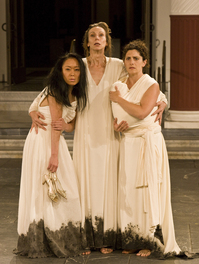SITI Company's 'Trojan Women' a powerful rendering of powerless women

Photo provided by SITI Company
In SITI Company’s “Trojan Women (After Euripides),” now being presented by the University Musical Society, a Greek envoy (Leon Ingulsrud) expresses contempt for a Trojan priest (Barney O’Hanlon) who’s castrated himself in the name of his goddess, noting that this would seem to prove what he’d heard: that Trojans are “weak like women.”
But “weak” and “powerless” are far from the same thing; and if Jocelyn Clarke’s adaptation of this 2,400 year old tragedy demonstrates nothing else, it shows the way that women, since ancient times, have always had to draw from unfathomable stores of strength in order to carry on and re-build in the face of mankind’s constant stream of wars.
So although the play’s four “powerless” royal Trojan women, following the fall of Troy, await news of which Greek warrior has claimed them for a slave or a wife, not one of them could be called “weak.”
Chief among them is Hecuba (Ellen Lauren), Troy’s now-kingless queen; her mad, virgin priestess daughter Kassandra (Akiko Aizawa); her daughter-in-law Amdromache (Makela Spielman), who mourns her fallen husband Hector while clinging to his infant son; and Helen (Katherine Crockett), the vain beauty at the center of Troy’s grueling 10 year war.
But the show begins with Poseiden (Brent Werzner), who provides backstory about how and why his favored city, Troy, fell. The scene/speech is important, because it sets the tone for the whole production. On a mostly bare stage, with some overturned chairs and a large, central circle made up of what appears to be dark pebbles, composer/violinist Christian Frederickson is visible in the (exposed) wings as Werzner takes deliberate, slow steps to his mark. Wearing a simple, aqua-colored tank and pants, Werzner stands center stage and delivers his tale, revealing a golden apple that lies at the center of the actor’s strong, graceful arm movements (which gives the audience's eyes something to follow while being filled in on all the details).
All this prepares the audience for the stylized nature of the production, which is nothing short of a wonder, thanks primarily to lead actress Lauren. Upon her first entrance, she lies prostrate with grief upon the pebbles, burying her hands, and the visceral power of this gesture, and all that follow it, is palpable. When Hecuba forces herself to sing, and howls in unbearable agony, and argues for Helen’s death, she reveals a woman who’s lost everything, and is struggling mightily to find a reason for hope or a future. It’s an unforgettable performance that, on opening night, choked me up. (This surprised me because, A, I’m not a big crier generally; and B, every time I’ve watched a production of an ancient play like “Trojan Women,” I’ve felt very disconnected emotionally - so SITI and Clarke are clearly on to something in translating this work for a contemporary audience.)
That having been said, I’ll admit that I had a recent refresher course in the Trojan War by way of reading Madeline Miller’s novel, “The Song of Achilles,” and this helped me catch a lot of “Trojan Women”’s backstory more easily; and because I have really young children myself, the portions of the play that focused on Andromache and the fate of her infant son hit me hard. So some might struggle to keep track of all the names flying around, and some might also not be as deeply affected by the play’s anchoring storyline (during which Clarke, unlike Euripides, provides the women with a single scrap of personal agency). Indeed, the fellow down the row from me seemed to be fighting to stay awake.
Plus, the intermissionless, 100 minute play is what one might call “wordy." But because of director Anne Bogart's thoughtful, spare, darkly atmospheric vision, and Clarke’s strong sense of what drives the play, the show carried me along fairly effortlessly.
The production isn’t set in a particular time or place, so Melissa Trn’s costumes project a timeless classicism and stay within the stark palette of black, white, or neutrals (with the exception of Poseiden). Brian H. Scott’s often-eerie lighting is key to establishing the show’s world, especially in moments like when Kassandra receives visions of the future. And Frederickson’s music haunts the action, underlining certain passages while never veering into heavy-handedness.
Bogart, in her liner notes and elsewhere, says that “Trojan Women” has endured as a favorite worldwide, despite many scholars’ claim that the play is flawed because “nothing happens.” But after seeing SITI’s profound production, and watching the play’s events unfold, I can’t help but wonder if the play’s tight focus on women subtly fuels the academics' critique: that women’s pain is reflexively viewed as “duller” and “less compelling” than men’s battlefield woes. Because in truth, there are several suspenseful scenes in “Trojan Women,” and dramatic questions do, in fact, keep it pushing forward.
“No one will sing of us in times to come,” mourns a character at play’s end. But SITI is singing in full voice of this ancient, war-ravaged city, as well as of these strong women - and blessings upon the artists' heads for doing it so well.
The play will be performed again at 2 p.m. Sunday, April 28. For background, see the preview article. For ticket information, see ums.org.
Jenn McKee is an entertainment reporter for AnnArbor.com. Reach her at jennmckee@annarbor.com or 734-623-2546, and follow her on Twitter @jennmckee.

